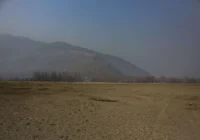In this guest edition of The Interview, Vikram Zutshi talks to physicist, activist and author Fritjof Capra.
Fritjof Capra is an Austrian-born American physicist, systems theorist and deep ecologist. He has written many popular books that connect conceptual changes in science with broader changes in worldview and values in society, notably The Tao of Physics: An Exploration of the Parallels Between Modern Physics and Eastern Mysticism. The book demonstrates striking parallels between Oriental mystical traditions and the discoveries of 20th-century physics. It has been published in 43 editions in 23 languages and is referenced with the statue of Shiva in the courtyard of one of the world’s largest and most respected centers for scientific research: CERN, the Center for Research in Particle Physics in Geneva.
The parallel between Shiva’s dance and the dance of subatomic particles was first discussed by Capra in an article titled “The Dance of Shiva: The Hindu View of Matter in the Light of Modern Physics,” published in Main Currents in Modern Thought in 1972. Shiva’s cosmic dance then became a central metaphor in Capra’s international bestseller, The Tao of Physics.
Over the past 30 years, Capra has been engaged in a systematic exploration of how other sciences and society are ushering in a similar shift in worldview, or paradigms, leading to a new vision of reality and a new understanding of the social implications of this cultural transformation. His most recent book, The Systems View of Life, presents a grand new synthesis of this work, integrating the biological, cognitive, social and ecological dimensions of life into one unified vision.
In this guest edition of The Interview, Vikram Zutshi talks to Capra about connecting the dots between life and science.
Vikram Zutshi: In The Turning Point: Science, Society, and the Rising Culture, you trace the history of science and economics, highlighting the flaws in the Cartesian, Newtonian and reductionist paradigms. You explain how such viewpoints have grown inadequate for modern technology and ecology needs, and argue that science needs to develop the concepts and insights of holism and systems theory to solve the complex problems we face as a species. Could you elaborate on this theme for readers who may not be familiar with your work?
Fritjof Capra: When I wrote The Tao of Physics, I believed that the “new physics” could be a model for the other sciences and for society in general, just as the old Newtonian physics had been, for many centuries, a model for other sciences and for social organization. What I had to realize was that most of what we encounter in our environment is alive. When we relate to our fellow human beings, to the living nature around us, to human organizations and to the economy, we are always dealing with living systems. Physics cannot say much about these living systems. It can provide knowledge about material structures, but the very nature of life is something that eludes physics.
With this realization, my research interests shifted from physics to the life sciences, and over the last 30 years I have explored and synthesized a new scientific conception of life that is emerging at the forefront of science. My synthesis is a conceptual framework that integrates four dimensions of life: the biological, the cognitive, the social and the ecological dimension. I presented summaries of this framework, as it evolved, in several books, beginning with The Turning Point in 1982. By “the turning point” I meant the fundamental change of worldview that is now occurring in science and in society, a change of paradigms from seeing the world as a machine to understanding it as a network.
Vikram Zutshi: In Belonging to the Universe: Explorations on the Frontiers of Science and Spirituality, you explore parallels between ways of thinking in science and Christian theology. What are the principal findings and conclusions of the book?
Fritjof Capra: I would say the principal conclusion was that the sense of oneness, which is the key characteristic of spiritual experience, is fully confirmed by the understanding of reality in contemporary science. Hence, there are numerous similarities between the worldviews of mystics and spiritual teachers — both Eastern and Western — and the systemic conception of nature that is now being developed in several scientific disciplines.
When we look at the world around us, we find that we are not thrown into chaos and randomness, but are part of a great order, a grand symphony of life. Every molecule in our body was once a part of previous bodies — living or nonliving — and will be a part of future bodies. In this sense, our body will not die but will live on, again and again, because life lives on. Moreover, we share not only life’s molecules, but also its basic principles of organization with the rest of the living world. Indeed, we belong to the universe, and this experience of belonging can make our lives profoundly meaningful.
Vikram Zutshi: How would you distinguish between spirituality and religion?
Fritjof Capra: In one of my last books, The Systems View of Life, coauthored with Pier Luigi Luisi, we have a whole chapter on “Science and Spirituality.” In it we emphasize the importance of distinguishing between spirituality and religion. Spirituality is a way of being grounded in a certain experience of reality that is independent of cultural and historical contexts.
Religion is the organized attempt to understand spiritual experience, to interpret it with words and concepts, and to use this interpretation as the source of moral guidelines for the religious community. Religious interpretations of spiritual experience always depend on historical and cultural contexts, and unfortunately they are often in danger of becoming dogmatic, requiring from the faithful to accept their pronouncements, moral codes and hierarchical structures as literal truths. When that happens, a comparison between science and religion is no longer fruitful.
Vikram Zutshi: In The Systems View of Life you and your co-author offer radical solutions to 21st-century challenges by focusing on the connected world and examining life through its inextricably linked systems. What are some of these radical solutions?
Fritjof Capra: For me, The Systems View of Life is my final synthesis of the new conception of life that has emerged at the forefront of science. I call it “the systems view of life” because it requires a new kind of thinking — thinking in terms of relationships, patterns and context. In science this is known as systemic thinking, or “systems thinking.”
The new systemic conception of life is not only fascinating intellectually, but has very concrete applications. In the last part of our book, we discuss the critical importance of the systems view of life for dealing with the problems of our multi-faceted global crisis. Today, it is becoming more and more evident that the major problems of our time — energy, environment, climate change, economic inequality, violence and war and so on — cannot be understood in isolation. They are systemic problems, which means that they are all interconnected and interdependent, and they require corresponding systemic solutions — solutions that do not solve any problem in isolation but deal with it within the context of other related problems.
Unfortunately, this realization has not yet dawned on most of our political and corporate leaders who are unable to “connect the dots,” to use a popular phrase. Instead of taking into account the interconnectedness of our major problems, their so-called “solutions” tend to focus on a single issue, thereby simply shifting the problem to another part of the system — for example, by producing more energy at the expense of biodiversity, public health or climate stability.
Systemic solutions, typically, solve several problems at the same time. Let me give you just one example from agriculture. If we changed from our chemical, large-scale industrial agriculture to organic, community-oriented, sustainable farming, this would contribute significantly to solving three of our biggest problems. It would greatly reduce our energy dependence, because we are now using (at least in the United States) one-fifth of our fossil fuels to grow and process food. The healthy, organically grown food would have a huge positive effect on public health, because many chronic diseases — heart disease, stroke, diabetes and so on — are linked to our diet. And finally, organic farming would contribute significantly to fighting climate change by drawing CO2 from the atmosphere and locking it up in organic matter.
This is just one example. In our textbook, we dedicate about 60 pages to detailed discussions of the most effective systemic solutions. They include proposals to reshape economic globalization and restructure corporations; new forms of ownership that are not extractive but generative; a wide variety of systemic solutions to the interlinked problems of energy, food, poverty and climate change; and, finally, the large number of systemic design solutions known collectively as ecodesign, which embody the basic principles of ecology.
In conclusion, I would like to say that a full discussion of the systems view of life and its applications would require a seminar of several days or, better still, a course of several weeks. In fact, I am now teaching such a course online. It is called Capra Course and consists of 12 pre-recorded lectures plus an online discussion forum in which I participate during the entire duration of the course. So far, participants from over 50 countries around the world have taken the course, including many participants from India.
The views expressed in this article are the author’s own and do not necessarily reflect Fair Observer’s editorial policy.
Photo Credit: Ezume Images / Shutterstock.com
Support Fair Observer
We rely on your support for our independence, diversity and quality.
For more than 10 years, Fair Observer has been free, fair and independent. No billionaire owns us, no advertisers control us. We are a reader-supported nonprofit. Unlike many other publications, we keep our content free for readers regardless of where they live or whether they can afford to pay. We have no paywalls and no ads.
In the post-truth era of fake news, echo chambers and filter bubbles, we publish a plurality of perspectives from around the world. Anyone can publish with us, but everyone goes through a rigorous editorial process. So, you get fact-checked, well-reasoned content instead of noise.
We publish 2,500+ voices from 90+ countries. We also conduct education and training programs
on subjects ranging from digital media and journalism to writing and critical thinking. This
doesn’t come cheap. Servers, editors, trainers and web developers cost
money.
Please consider supporting us on a regular basis as a recurring donor or a
sustaining member.
Will you support FO’s journalism?
We rely on your support for our independence, diversity and quality.







